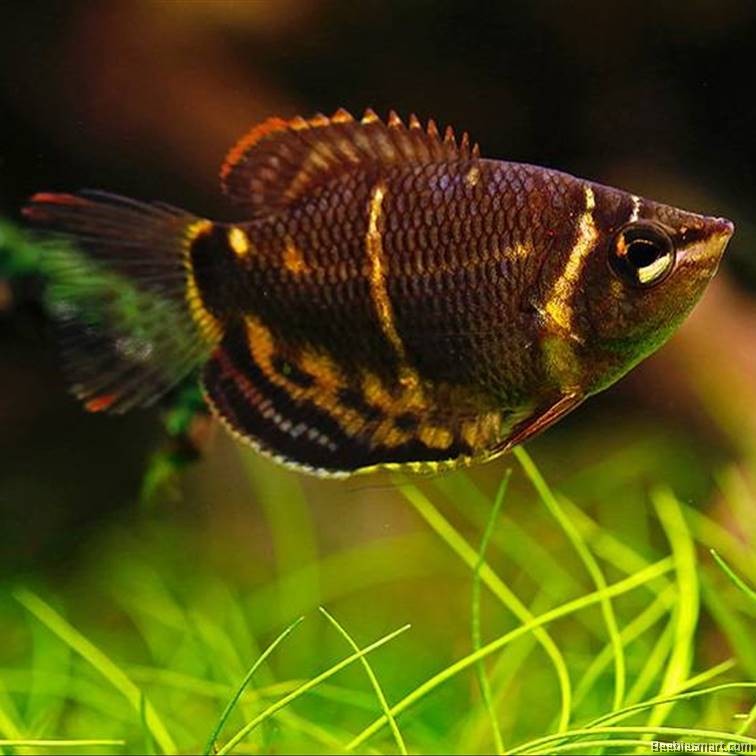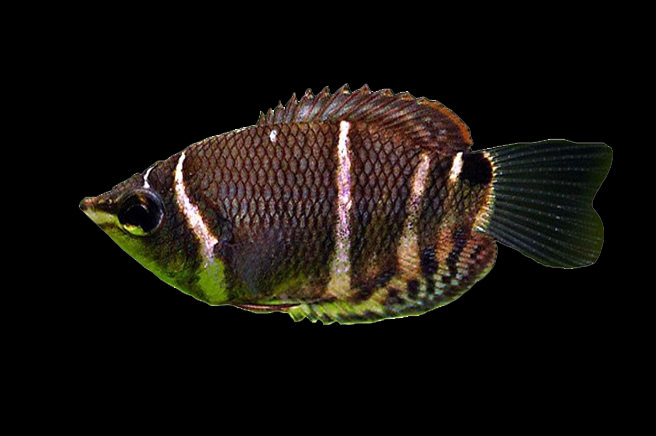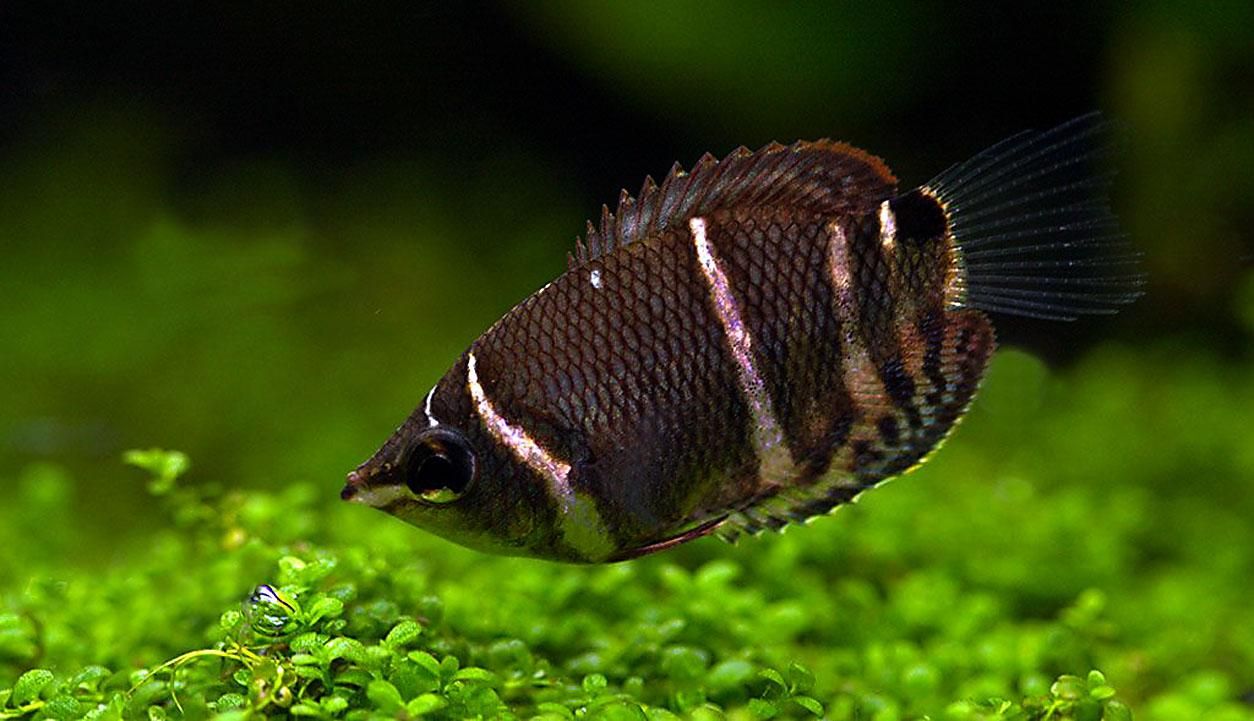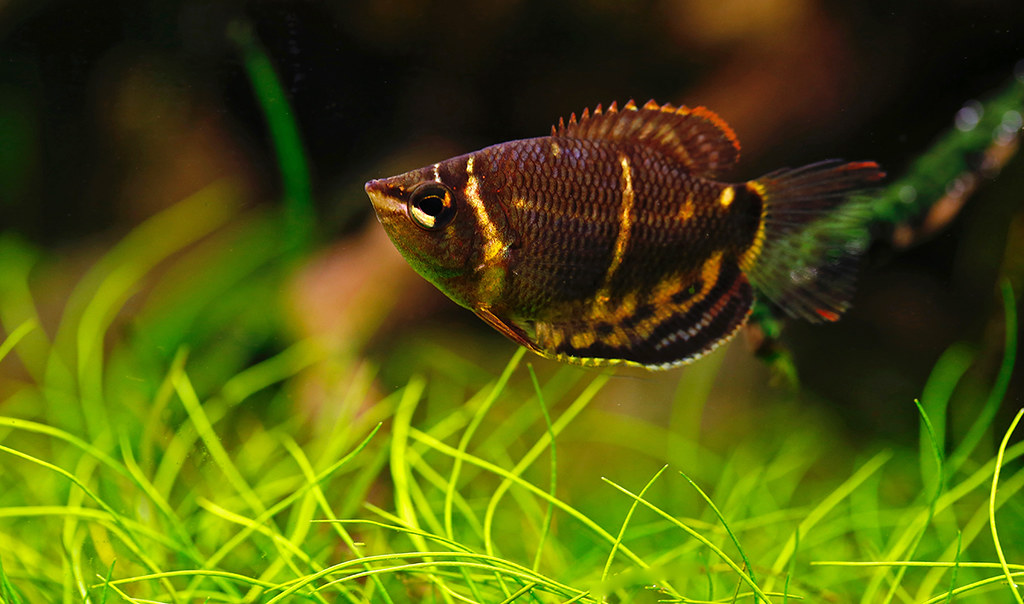
Chocolate Gourami Fish Breed | A Guide on Caring for Gourami
Species fundamental features
Latin Name: Sphaerichthys osphromenoides Canestri, 1860.
Family: Osphronemidae
Subfamily: Trichogastrinae
Chocolate Gourami is a small fish, no more than 5 cm long, with a flat-shaped body. It shows the typical characteristics found in all members of this family: filiform ventral fins, and the labyrinth; a specialized organ in the use of atmospheric air. Brown coloured (it gets its name from that), with several cream coloured stripes, which change according to its mood.

It also shows a characteristic cream, brown and black pattern on the anal and part of the tail fin. The filiform fins are not easily seen, and most of the time stay folded over the body. It’s a mouthbrooder. Sex differences are not very significant in low breeding activity periods but are outstanding when breeding. Males show a pronounced cream/white edge mainly on the dorsal fin and a more intense reddish body. Females are rounder and acquire a less intense colour, showing a dark spot on the tail fin.
Breeding set up for Chocolate Gourami
We can choose from two possibilities to try to breed it:
– Keep a more or less crowded bunch in a certain size aquarium, for example, 10 fish in 150 to 200L.
– Or have a couple in an only-breeding aquarium.
In both cases, water parameters must be fairly good. The appropriate parameters are: pH 5-6,5; GH 0-4 and GH 0-5; nitrates, nitrites and phosphates must be kept as low as possible. The more acidic and purer the water (referring to dissolved salts) the better they will be and the higher the breeding chances are.

Concerning the aquarium equipment, we must have in mind this Chocolate Gourami fish’s shyness and therefore try to offer an appropriate environment. Plants are a must, as well as tree roots and logs, which help us to get the right pH. Another option we have is to introduce some dry leaves, which must be hard or they will disintegrate in a few days. I have had good results with the Platanus hispanica and Quercus faginea leaves.
Other more than appropriate species could include Fagus sylvatica and any other species of the Quercus genus. The plants we can introduce belong mainly to the Cryptocorine genus, as well as the Microsorum Pteropus and some other fast growers such as the Cerathophyllum demeresum. As floating plants, we can put Limmovium laeviagatum and Pistia strategies. As we will see further on, in the fry’s aquaria, introducing Riccia fluitans and Vesicularia daubiana can be a fine solution.
If we set a large tank for a breeding group, powerful filtration is a must. For a breeding pair aquaria, a corner sponge filter and weekly water changes are more than enough. Nevertheless I always tend to oversize all filters when concerning this particular Chocolate Gourami fish.
Once the aquaria are fully set up and all Chocolate Gourami fish are in it, we should encourage them to breed. The right conditions are easily set: water temperature should be around 27-28º C, and so should be air temperature. If we have open aquariums and all other parameters are OK, breeding will only happen when the air temperature is appropriate. Water must be kept as soft and acid as possible, as well as free of any kind of nitrogen compounds, easily done by regular water changes with osmosis water in the right proportions.
We should not forget about feeding, as the Chocolate Gourami fish’s health will be directly related. We should provide live or frozen food such as red or black larvae, water fleas, grindal worms, brine shrimp, etc.
If all goes well, we will soon see outstandingly beautiful colours in our Chocolate Gourami fish, and we can verify how males fight among themselves and display beside the females. At this time we must decide if we will try to breed them in a group, or as a couple in a separate aquarium. Both methods are equally valid.
The male will court the female inducing her to spawn in an open space. If she is willing, the male will quickly fertilize the eggs, and right away she will pick them up in her mouth. Having kept chocolate gouramis for two years, I have not been able to see this particular behaviour, as it takes place in the most hidden parts of the aquaria where it is difficult to see.
If we decided on the “separate couple” method, as soon as the female shows a noticeably swollen throat we can take out the male, leaving the female by herself, keeping a soft light. It’s also recommendable to cover the aquaria to avoid shocking her. If she is in the aquaria with the rest of the group, we should not fear for her, just needing to keep an eye on her the few days she carries the eggs.
When she carries the eggs in her mouth, the symptoms are more than evident, as well as a swollen throat (noticeable or not) she shows an apathetic behaviour, staying out of the way of all males and refusing to eat. She seems to seek food, but obviously cannot swallow it, just staring at it. She also moves her mouth often, just like she was chewing something (obviously the eggs), and when she swims up to breathe loses some bubbles on the way down. (Concerning this, some authors mention that she also occasionally loses one or two fries, that are quickly swallowed again, but I have never seen this).
Breeding for Chocolate Gourami Fish

If all goes well, after 8 days she will let all fry out. If during the first 3 to 5 days, all “pregnancy” symptoms vanish, it means that the eggs were not fertilized and they probably produced a bad taste causing her to either eat them or spit them out.
Seven days after, if the female has remained with the rest of the group, Chocolate Gourami should be taken to a separate spawning aquarium where we have previously placed some dry leaves, twigs, Java moss, Riccia fluitans and Limmovium laeviagatum. The temperature and water in this aquarium should be exactly the same as in the first one.
On the 8th day, she will begin to “give birth”, at first just a few fries, growing in number as the day goes on, making a total of 40 to 60 (as far as I can tell). It’s more than vital that the birthing aquarium was set up long before, therefore having much moss and riccia, as these plants will provide food for the fry since rotifers and Cyclops grow spontaneously among them.
If this was not our case, we must have newly hatched artemia ready to be given to the Chocolate Gourami fry, because if they do not eat in the next few hours, they will starve to death. Once all the fry has come out of the female we can take her away and re-introduce her in the main aquarium.
Chocolate Gourami fry is born totally formed and is approximately 7 mm long. They show at this very instance a reddish/brownish colour with a cream coloured stripe right in the middle of their bodies. They will eagerly feed on newly hatched brine shrimp, which should be given to them several times a day. Daily water changes and gravel vacuum cleaning are a must to remove any unhatched shrimp eggs that could have been accidentally introduced.
Maintain this feeding routine for a month or so, by which time chocolate Gourami should have acquired a fully adult shape, only differing in size (1,5 or 2 cm long). At this time we should vary their feeding, introducing some type of dry micronized food, or something like small-sized mosquito larvae. After 2 months they will eat just about anything they can get in their mouth. But we should not stop suddenly providing them brine shrimp, it must be stopped gradually.
I must say chocolate Gourami fry mortality in my particular case has not been too high, about 2 to 4 fry per spawn. It mainly happens in the first few weeks, probably directly related with the growth of the labyrinth (the special organ used to breathe atmospheric air), or maybe it has something to do with a few fries not eating well-becoming weak and eventually dying. Anyway, if we keep the feeding and cleaning routines constant, mortality should below.
